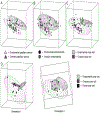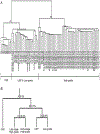Genomic analysis of epithelial ovarian cancer
- PMID: 18427574
- PMCID: PMC7185304
- DOI: 10.1038/cr.2008.52
Genomic analysis of epithelial ovarian cancer
Abstract
Ovarian cancer is a major health problem for women in the United States. Despite evidence of considerable heterogeneity, most cases of ovarian cancer are treated in a similar fashion. The molecular basis for the clinicopathologic characteristics of these tumors remains poorly defined. Whole genome expression profiling is a genomic tool, which can identify dysregulated genes and uncover unique sub-classes of tumors. The application of this technology to ovarian cancer has provided a solid molecular basis for differences in histology and grade of ovarian tumors. Differentially expressed genes identified pathways implicated in cell proliferation, invasion, motility, chromosomal instability, and gene silencing and provided new insights into the origin and potential treatment of these cancers. The added knowledge provided by global gene expression profiling should allow for a more rational treatment of ovarian cancers. These techniques are leading to a paradigm shift from empirical treatment to an individually tailored approach. This review summarizes the new genomic data on epithelial ovarian cancers of different histology and grade and the impact it will have on our understanding and treatment of this disease.
Figures





References
-
- Jemal A, Siegel R, Ward E, et al. Cancer statistics, 2008. CA Cancer J Clin 2008; 58:71–96. - PubMed
-
- Cannistra SA. Cancer of the ovary. N Engl J Med 2004; 351:2519–2529. - PubMed
-
- Bhoola S, Hoskins WJ. Diagnosis and management of epithelial ovarian cancer. Obstet Gynecol 2006; 107:1399–1410. - PubMed
-
- Ozols RF, Rubin SC, Thomas GM, Robboy SJ. Epithelial ovarian cancer In: Hoskins WJ, Young RC, Markman M, Perez CA, Barakat R, Randall M, eds. Principles and Practice of Gynecologic Oncology. Philadelphia, PA: Lippincott Williams & Wilkins, 2005:895–988.
-
- Yawn BP, Barrette BA, Wollan PC. Ovarian cancer: the neglected diagnosis. Mayo Clin Proc 2004; 79:1277–1282. - PubMed
Publication types
MeSH terms
Grants and funding
LinkOut - more resources
Full Text Sources
Other Literature Sources
Medical

